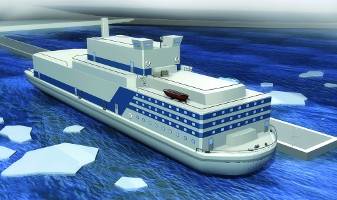Cathelco Protects Floating Nuclear Power Plant
A prototype for a series of Russian floating nuclear power stations will be protected against hull corrosion with a Cathelco impressed current cathodic protection system (ICCP).
Designed to provide nuclear power in remote regions of the Arctic, the hull of the floating power plant is being constructed at the Baltiysky Zavod yard in St Petersburg. It will then be installed with two nuclear reactors providing up to 70 megawatts of electricity – enough to serve a city with a population of 200,000.
The Cathelco ICCP system will protect the submerged surface of the hull against corrosion by ‘neutralising’ electro-chemical activity. It consists of a control panel and an arrangement of anodes and reference electrodes mounted on the surface of the hull.
The reference electrodes measure the electrical potential at the hull/seawater interface and send a signal to the control panel which raises or lowers the output to the anodes, ensuring the optimum level of corrosion protection at all times.
“The Cathelco ICCP system has been specifically designed for Arctic conditions where the temperature of the seawater results in lower conductivity than in warmer climates. In these circumstances, a higher current density is required to achieve polarization of the hull and prevent corrosion. These factors have been taken into consideration in the specification of the control panel and anodes,” said Anna Siodlak, who has co-ordinated the project at Cathelco.
The order for the equipment was won by Marine Bridge & Navigation Systems, Cathelco’s agent based in St Petersburg.
Cathelco is supplying a 300amp system for the vessel with two elliptical anodes positioned port and starboard at the stern and a further two midships. Both the anodes and reference electrodes are diver changeable enabling them to be replaced without the need for drydocking, an important factor in vessels with long operational lives and infrequent drydocking periods.
Construction of the vessel, the Akademik Lomonosov began in 2007 and work is planned to be completed in 2011. It will then be towed to a position off the coast at Vilyuchinsk, a town in the far East of Russia.
With a length of 374 ft, a width of 98.4 ft and a displacement of 21,500 tonnes, the floating power plant is the first in the world to be mass produced by Rosatom, the Russian state nuclear authority.
Five of the vessels will be built for Gazprom, Russia’s largest energy provider, enabling it to use power drilling equipment to exploit some of the remotest oil and gas fields in the world in the Barents and Kara seas.
The advantage of offshore nuclear plants is that they can be built in a shipyard and towed to their area of operation as completed units. They can be used to provide domestic power supplies in remote areas or utilised as power sources for water desalination which uses large amounts of electricity. Beyond this they have applications as power providers in offshore oil and gas fields during drilling.
www.cathelco.com













